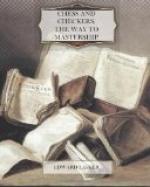Black plays
(1) 7-2
threatening (2) 3-7 and (3) 15-11. White can prevent this only by
(1) ... 24-20
Now 3-7 would only draw on account of 16-11.
(2) 2-6 20-24 (3) 6-10 24-20
Again 3-7 had to be prevented.
(4) 10-14 20-24 (5) 14-17 24-27
This time 24-20 would have lost, as Black would have replied (6) 17-13, 20-24; (7) 3-7, 12-8; (8) 15-11.
(6) 17-13 27-32
Avoiding 27-24 which would lose by (7) 3-7
(7) 13-9 32-27 (8) 9-14 27-24 (9) 14-18 24-27
Drawn. White has to watch 3-7 and to take care to play 24-20 at the right time so as to exchange 16-11 if 3-7 is played. At the same time he must beware of playing 24-20 when the Black Kings are on squares 15 and 5 or 15 and 13, as otherwise Black would reply 5-9, 20-24; 3-7, 12-8; 15-11.
IV
GENERAL PRINCIPLES AND ILLUSTRATIVE GAMES
It is possible to apply general strategic principles to the game of Checkers, just as well as the game of Chess, even though there is not the scope in Checkers for strategic maneuvers on the grand scale on which they can be carried out in Chess.
Again it is naturally the principle of greatest mobility which should govern the plan of mobilization in any opening, and it is consequently more desirable to have the men work in the center of the board, than on the edge, where part of their range is cut off.
The advantage of center squares over side squares is not so marked in Checkers as it is in Chess. There is no doubt that a piece has more mobility in the center, where there are two or four moves to choose from, than on the side where only one or two moves are possible; but a man on the side has an advantage in so far as he is backed up by the edge of the board so that he is safe from being captured until he moves. However, a player who keeps his men in massed formation in the center will in almost all cases be able to make them protect each other and to win the upper hand against an opponent whose army is divided into two parts, one on the left and the other on the right side of the board.
When playing with the white men, it is advisable to occupy such squares as 14, 18, 19, 30, 31 and 32, and it is not advisable to occupy 5 and 12 whenever the opponent has a man on 1 or 3 respectively, as in that case the men have a tendency to act as supports for the enemy instead of helping their own side. In the position: Black 1, 7 and 9; White 5, 14, 18 and 22; for instance, White’s man on 5 supports Black’s man on 9 and White, on the move, has to surrender a piece by 22-17, to which Black replies 9-13.
It is naturally a good thing not to touch the men of the back row mentioned above, as they will prevent the opponent from getting Kings. White’s man 29 and Black’s man 4, however, are better off in the middle of the board, as the squares 25 and 8 are adequately guarded by 30 and 3 respectively. Moreover, there is danger of the first position arising from openings in which a player keeps his man in the single corner.




